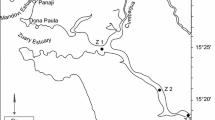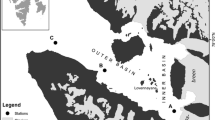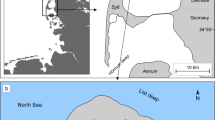Abstract
Samples were collected from September 1990 to February 1992, at three subtidal sites of the middle reaches of the Queule River estuary, southern Chile, to analyze the spatial and temporal variability of the macroinfauna inhabiting substrata with different abundances of bivalves. In addition, water and sediment samples were obtained to study the relationships between the temporal variability in macroinfaunal abundances, physical factors and chlorophylla content. Temperature, salinity, and chlorophylla showed a rather strong seasonal variability but slight between-site differences. Sediment characteristics and bivalve abundances, by contrast, exhibited little temporal variability but large differences between sites. The macroinfauna was primarily represented by polychaetesPrionospio (Minuspio) patagonica being dominant in the three areas. Most dominant species showed similar trends of temporal variability, with maximum abundances recorded during spring and fall. The appearance of recruits was restricted to the summer with little difference among sites. Multiple regression analyses showed that the temporal variability of macroinfaunal adults and recruits, was primarily associated with variability in salinity and water temperature, respectively. Spatial variability of these organisms was also explained by variations in these factors, together with those of sediment texture and organic matter content. No evidence of interactions (significant relationships) was found between the abundances of bivalves and those of the macroinfauna, nor among macroinfaunal organisms.
Similar content being viewed by others
Literature Cited
Anderson, F. E., L. Black, L. M. Mayer, andL. E. Watling. 1981. A temporal and spatial study of mudflat texture.Northeastern Geology 3:184–191.
André, C. andR. Rosenberg. 1991. Adult-larval interactions in the suspension feeding bivalvesCerastoderma edule andMya arenaria.Marine Ecology Progress Series 71:227–234.
Bachelet, G. 1986. Recruitment and year- to year variability in a population ofMacoma balthica (L.).Hydrobiologia 142:233–248.
Bertrán, C. 1989. Zonación y dinámica temporal de la macroinfauna intermareal en el estuario del Río Lingue (Valdivia, Chile).Revista Chilena de Historia Natural 62:19–32.
Beukema, J. J. 1990. Expected effects of changes in winter temperatures on benthic animals living in soft sediments in coastal North Sea areas, p. 83–92.In J. J. Beukema et al. (eds.), Expected Effects of Climatic Change on Marine Coastal Ecosystems. Kluwer Academic Publishers, The Netherlands.
Beukema, J. J. andG. C. Cadée. 1986. Zoobenthos responses to eutrophication of the Dutch Wadden Sea.Ophelia 26:45–64.
Bravo, A. 1989. Variación temporal de la macroinfauna submareal del río Queule (IX Región, Chile). M.S. Thesis, Universidad Austral de Chile. Valdivia-Chile.
Butman, C. A. 1987. Larval settlement of soft-sediment invertebrates: The spatial scales of pattern explained by active habitat selection and the emerging role of hydrodynamical processes.Oceanography and Marine Biology Annual Review 25: 113–165.
Dethier, M. N. 1984. Disturbance and recovery in intertidal pools: Maintenance of mosaic patterns.Ecological Monographs 54:99–118.
Dittman, S. 1990. Mussel beds—Amensalism or amelioration for intertidal fauna?Helgoländer Meeresunterschungen 44:335–352.
Folk, R. L. 1980. Petrology of Sedimentary Rocks. Hemphill Publishing Co., Austin, Texas.
Grassle, J. F. andJ. P. Grassle. 1974. Opportunistic life histories and genetic systems in marine benthic polychaetes.Journal of Marine Research 32:253–284.
Gray, J. S. 1974. Animal-Sediment relationships.Oceanography and Marine Biology Annual Review 12:223–264.
Hair, J. F., R. E. Anderson, R. L. Tatham, andB. J. Grablowsky. 1979. Multivariate Analysis. Petroleum Publishing Company, Tulsa, Oklahoma.
Haven, D. S. andR. Morales-Alamo. 1972. Biodeposition as a factor in sedimentation of fine suspended solids in estuaries.The Geological Society of America, Inc. 133:121–130.
Hines, A. H., M. H. Posey andP. J. Haddon 1989. Effects of adult suspension- and deposit-feeding bivalves on recruitment of estuarine infauna.Veliger 32:109–118.
Holland, A. F., A. T. Shaughnessy, andM. H. Hiegel. 1987. Long-term variation in mesohaline Chesapeake Bay macrobenthos: Spatial and temporal patterns.Estuaries 10:227–245.
Jaramillo, E., C. Bertrán, G. Aguilar, A. Turner, andM. Pino. 1985. Annual fluctuations of the subtidal macroinfauna in an estuary of south of Chile.Studies on Neotropical Fauna and Environment 20:33–44.
Jaramillo, E., C. Bertrán, andA. Bravo. 1992. Community structure of the subtidal macroinfauna in an estuarine mussel bed in southern Chile.Marine Ecology, P.S.Z.N.I. 13:317–331.
Jaramillo, E., C. Bertrán, andA. Bravo. 1993. Mussel biodeposition in an estuary in southern Chile.Marine Ecology Progress Series 82:85–94.
Johnson, R. G. 1977. Vertical variation in particulate matter in the upper twenty centimeters of marine sediments.Journal of Marine Research 35:273–282.
Levin, L. A. 1984. Life history and dispersal patterns in a dense infaunal polychaete assemblage: Community structure and response to disturbance.Ecology 65:1185–1200.
Low, A. 1993. Distribución y abundancia de la pequeña macroinfauna estival en tres estuarios micromareales del sur de Chile. Marine Biologist Thesis, Universidad Austral de Chile, Valdivia, Chile.
Nichols, F. H., J. E. Cloern, S. N. Luoma, andD. H. Peterson, 1986. The modification of an estuary.Science 231:525–648.
Olafsson, E. B. 1986. Density dependence in suspension-feeding and deposit-feeding populations of the bivalveMacoma balthica: A field experiment.Journal of Animal Ecology 55:517–526.
Paterson, D. M. andG. R. Daborn. 1991. Sediment stabilisation by biological action: Significance for coastal engineering, p. 111–118.In Developments in Coastal Engineering Symposium. University of Bristol, Bristol, United Kingdom.
Peterson, C. H. 1979. Predation, competitive exclusion, and diversity in the soft-sediment communities of estuaries and lagoons, p. 233–264.In R. J. Livingston (ed.), Ecological Processes in Coastal and Marine Systems. Plenum Press, New York.
Petterson, C. H. andR. Black. 1987. Resource depletion by active suspension feeders on tidal flats: Influence of local density and tidal elevation.Limnology and Oceanography 32:143–166.
Pethick, J. 1984. An Introduction to Coastal Geomorphology. Edward Arnold (Publishers) Ltd. London.
Pino, M. andS. Mulsow. 1983. Distribución de facies granulométricas en el estuario del río Queule: Un análisis de componentes principales.Revista Geológica de Chile 18:77–85.
Posey, M. H. 1987. Influence of relative mobilities on the composition of benthic communities.Marine Ecology Progress Series 39:99–104.
Posey, M. H. 1990. Functional approaches to soft-substrate communities: How useful are they?Reviews, in Aquatic Sciences 2:343–356.
Quijón, P. andE. Jaramillo. 1993. Temporal variability in the intertidal macroinfauna in the Queule River estuary, southcentral Chile.Estuarine Coastal and Shelf Sciences 37:655–667.
Reise, K. 1983. Biotic enrichment of intertidal sediments by experimental aggregates of the deposit-feeding bivalveMacoma balthica.Marine Ecology Progress Series 12:229–236.
Reise, K. 1985. Tidal flat Ecology: An Experimental Approach to Species Interactions. Springer-Verlag, New York.
Rhoads, D. C. andD. K. Young. 1970. The influence of deposit-feeding organisms on sediment stability and community trophic structure.Journal of Marine Research 28:150–178.
Rhoads, D. C. andL. F. Boyer. 1982. The effects of marine benthos on physical properties of sediments. A succesional perspective, p. 3–52.In P. L. McCall and M. J. S. Tevesz (eds.), Animal-sediment Relations. The Biogenic Alteration of Sediments. Plenum Press, New York.
Risk, M. J. andJ. S. Moffat. 1977. Sedimentological significance of fecal pellets ofMacoma balthica in the Minas Basin Bay of Fundy.Journal of Sedimentary Petrology 47:1425–1436.
Rojas, C. 1984. Dinámica anual del seston en el estuario del Río Queule, IX Región.Revista de Biología Marina de Valparaíso 20:139–157.
Roman, R. M. andK. R. Tenore 1978. Tidal resuspension in Buzzards Bay, Massachusetts. I. Seasonal changes in the resuspension of organic carbon and chlorophylla.Estuarine and Coastal Marine Sciences 6:47–53.
Sha, L. P. and P. L. de Boer. 1991. Ebb-tidal delta deposits along the west Frisian Island (The Netherlands): Processes, facies architecture and preservation, p. 199–218.In D. G. Smith, G. E. Reinson, B. A. Zaitlin, and R. A. Rahmani (eds.), Clastic Tidal Sedimentology: Canadian Society of Petroleum Geologists, Memoir 16. Calgary.
Sokal, R. R. andF. J. Rohlf. 1969. Biometría. H. Blume Ediciones, Madrid.
Souza, W. P. 1979. Disturbance in marine intertidal boulderfields: The nonequilibrium maintenance of species diversity.Ecology 60:1225–1239.
Stoline, M. R. 1981. The status of multiple comparisons: Simultaneous estimation of all pairwise comparisons in one-way ANOVA designs.The American Statistician 35:134–141.
Strickland, J. D. and T. R. Parsons. 1972. A practical handbook of seawater analysis. Fisheries Research Board of Canada. Bulletin 167, Ottawa.
Thistle, D. 1981. Natural physical disturbances and communities of marine soft bottoms.Marine Ecology Progress Series 6:223–228.
Toro, J. E. 1984. Determinación de las fluctuaciones mensuales de la abundancia y de la biomasa fitoplanctónica en el estuario del Río Queule (Chile, IX Región).Revista de Biología Marine de Valparaíso 20:23–37.
Vooys, C. G. N. de 1990. Expected biological effects of longterm changes in temperatures, on benthic ecosystems in coastal waters around The Netherlands, p. 83–92.In J. J. Beukemaet al. (eds.), Expected Effects of Climatic Change on Marine Coastal Ecosystems. Kluwer Academic Publishers, The Netherlands.
Vos, P. C., P. L. de Boer, andR. Misdorp. 1988. Sediment stabilization by benthic diatoms in intertidal sandy shoals; qualitative and quantitative observations, p. 511–526.In P. L. de Boer, A. van Gelder, and S. O. Nio (eds.), Tide-influenced Sedimentary Environments and Facies. D. Reidel Publishing Company, Dordrecht.
Wilson, W. H., Jr. 1990. Competition and predation in marine soft-sediment communities.Annual Review of Ecology and Systematics 21:221–241.
Woodin, S. A. 1976. Adult-larval interactions in dense infaunal assemblages: Patterns of abundance.Journal of Marine Research 34:25–41.
Author information
Authors and Affiliations
Rights and permissions
About this article
Cite this article
Quijón, P., Pino, M. Macroinfaunal assemblages associated with mussel and clam beds in an estuary of Southern Chile. Estuaries 19, 62–74 (1996). https://doi.org/10.2307/1352652
Received:
Accepted:
Issue Date:
DOI: https://doi.org/10.2307/1352652




